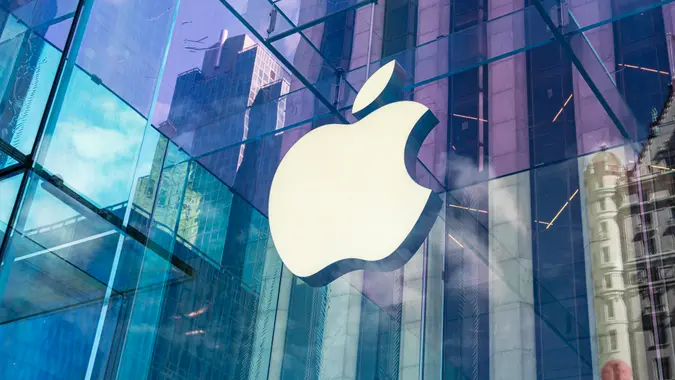Should You Be Concerned That Tech Stocks Make Up Nearly Half of the S&P 500?

Commitment to Our Readers
GOBankingRates' editorial team is committed to bringing you unbiased reviews and information. We use data-driven methodologies to evaluate financial products and services - our reviews and ratings are not influenced by advertisers. You can read more about our editorial guidelines and our products and services review methodology.

20 Years
Helping You Live Richer

Reviewed
by Experts

Trusted by
Millions of Readers
Rather than picking individual stocks, many investors simply buy an S&P 500 index fund to give them diversified exposure to the stock market. And for the average investor, this has proven to be a solid bet over time.
Even professional investors have a tough time outperforming the index on a consistent basis, so earning a market return year after year can be an excellent long-term strategy. Warren Buffett, one of the wealthiest and most respected investors of all time, has frequently said that the average investor is better off buying a low-cost index fund than trying to trade stocks.
But things may be changing for the so-called “diversified” S&P 500 index. If you’re one of the many investors who own an S&P 500 index fund, whether in your personal accounts or in your 401(k) plan, it’s time to take a look at the real composition of the index and evaluate whether or not it still fits within your investment objectives and risk tolerance.
The S&P 500 Is Weighted by Market Capitalization
Part of the problem with general investors buying an S&P 500 index fund is that many of them don’t truly understand how it operates. Hearing that the index holds “the 500 biggest companies in America” sounds like a strong, diversified investment that should carry low risk. But the truth of the matter is a bit different.
Although it’s true that S&P 500 index funds generally own the 500 largest companies in the U.S., its portfolio is weighted by market capitalization. This means that the bigger the company, the more weight it carries in the market.
This creates a vastly different effect than an equal-weighted index, in which each company in the index carries the same weight. It’s also a completely different creature than the Dow Jones Industrial Average, which is still price-weighted. This means that stocks in the widely quoted Dow are weighted by their share price.
Is Market Cap Weighting an Issue for the S&P 500?
The general concept of market cap weighting isn’t really an issue. The multiyear rally in tech stocks, however, has become one.
According to Barron’s, tech stocks, including household names like Apple (AAPL), Nvidia (NVDA) and Microsoft (MSFT), now make up a whopping 47% of the entire S&P 500 index. This means a single industry generates roughly half the gains — or losses — of the supposedly diversified S&P 500 index.
As the S&P 500 has companies from 11 different sectors, according to the Corporate Finance Institute, the remaining 53% of the index’s value is spread out over 10 other sectors.
In other words, investors looking for more or less equal exposure to America’s 11 dominant sectors won’t find it in an S&P 500 index fund. As it currently stands, the index is primarily a technology fund, with small portions of other industries thrown in.
Is the S&P 500 Really Diversified?
The dominance of tech stocks in the index should certainly be a concern for general investors in S&P 500 index funds. But another, perhaps equally concerning fact is that it’s not just a single industry that is generating the bulk of the index’s performance — it’s also just a handful of individual stocks.
As of Feb. 5, 2025, the top 10 stocks in the S&P 500 carried a cumulative 36% weighting in the index. That means just 10 stocks were responsible for more than one-third of the entire index’s performance. And the top 20 stocks accounted for more than 46% of the index’s weight, according to Slickcharts.
While in and of itself this doesn’t have to mean anything negative, the truth is that many investors in the index are expecting to get exposure to 500 major companies. While that is technically true, many of those companies have little to no effect on the return of the overall index.
If just 20 stocks make up nearly half the index’s weight, that means that the remaining half is spread out over 480 stocks, giving them hardly any representation at all.
The truth is that the S&P 500 is likely to continue outperforming even professional money managers over the long run. And it may even prove to be no big deal that the index is currently oversaturated with tech stocks and megacap companies.
But it’s still important for investors to understand what they are buying when they pick up shares of an S&P 500 index fund — because it certainly does not provide diversified, equally weighted exposure to America’s top industries.
More From GOBankingRates
- Nearly 1 in 3 Americans Hit by a Costly Holiday Scam, Norton Survey Shows -- How To Avoid This
- Here's What the Average Social Security Payment Will Be in Winter 2025
- How Middle-Class Earners Are Quietly Becoming Millionaires -- and How You Can, Too
- The Easiest Way to Score $250 for Things You Already Do
 Written by
Written by  Edited by
Edited by 
























